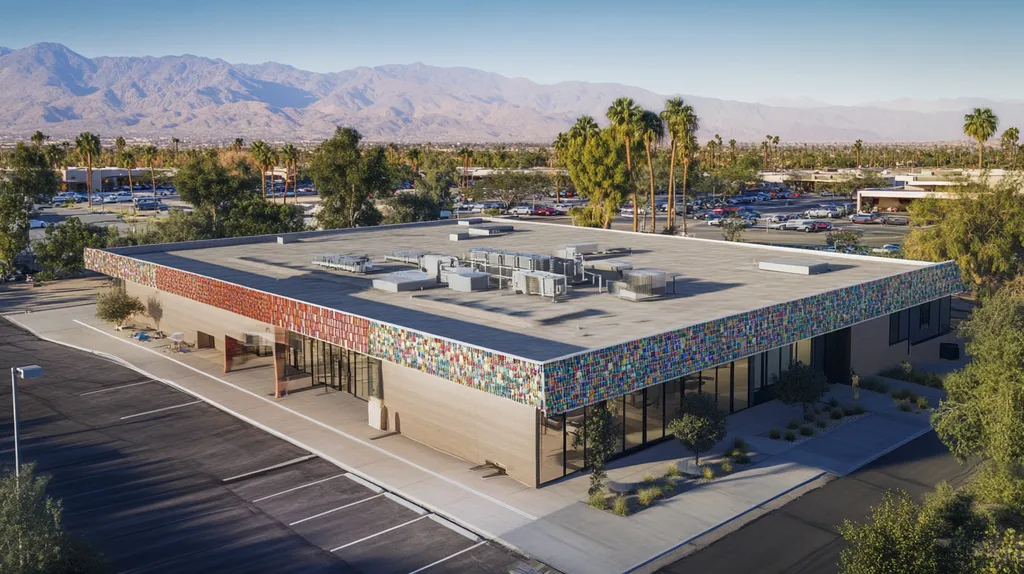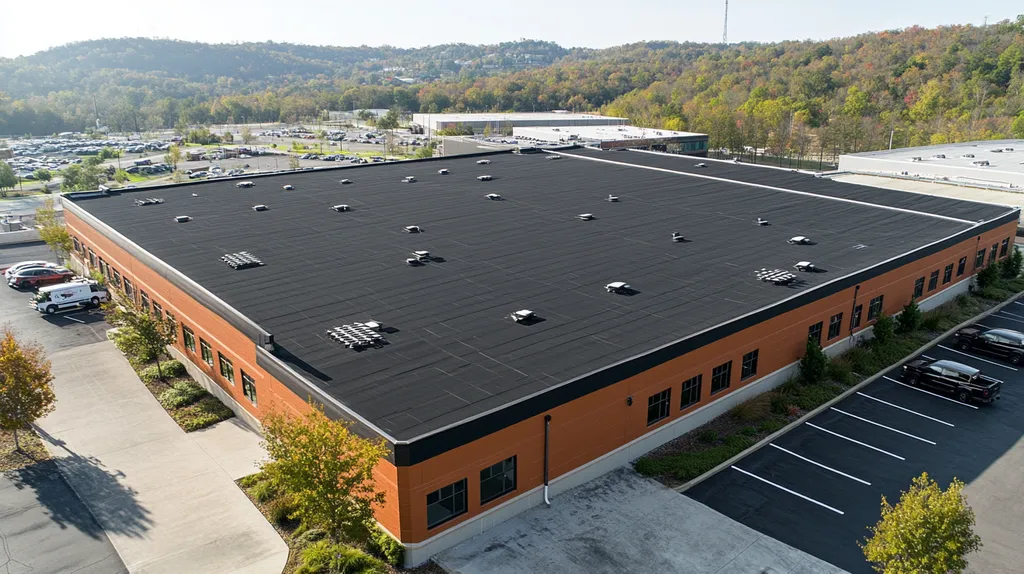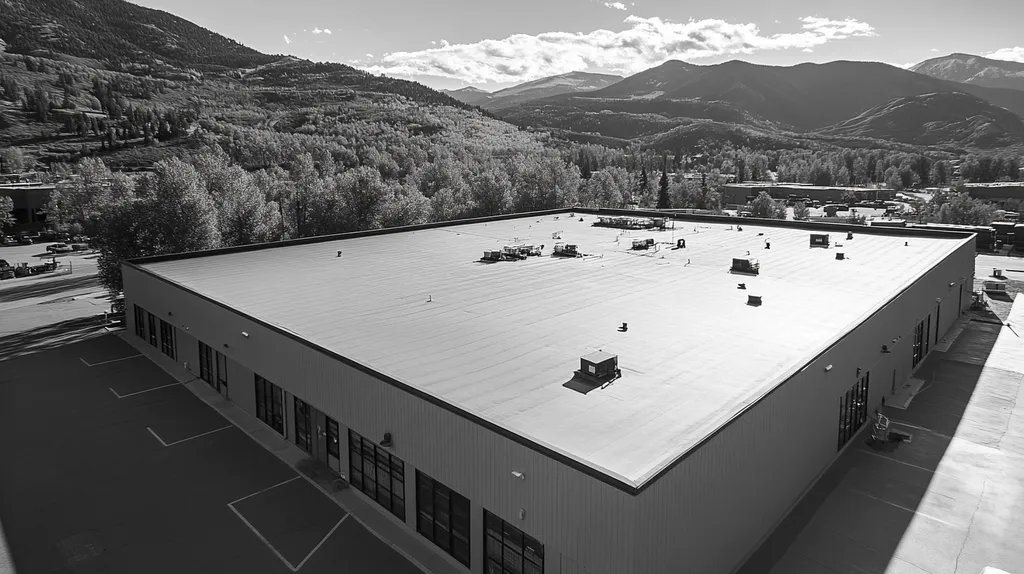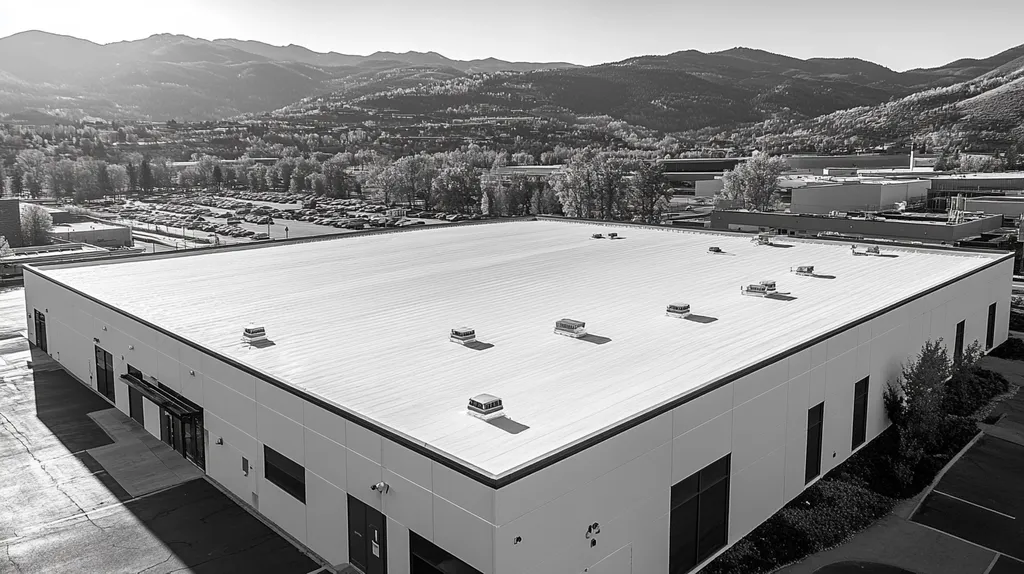Every year, commercial buildings lose millions in damage from a surprisingly simple oversight: poorly documented roof penetrations. Industry data shows that up to 80% of roof leaks occur around these critical access points where pipes, vents, and equipment pass through the roofing system.
Without proper documentation of these vulnerable areas, facility managers are essentially playing a costly game of chance with their building’s integrity.
This comprehensive guide breaks down the essential steps for documenting roof penetrations, from basic terminology to advanced maintenance strategies, helping property owners protect their investments and prevent water intrusion before it starts.
SECTION 1: THE BASICS EXPLAINED
Roof penetrations are the unsung heroes of your building’s roofing system, serving as exit points for essential components like ventilation, plumbing, and electrical lines. However, without proper documentation and attention, these seemingly innocuous spots can become major culprits in water intrusion—statistically, nearly 80% of roof leaks trace back to these areas. Ignoring their significance threatens the integrity of your roof and the valuable assets sheltered beneath it.
What It Is (In Plain Language)
In simple terms, roof penetrations are openings in the roof where pipes, vents, and other structures come through. These spots require meticulous sealing to prevent water from seeping in. If overlooked, they can lead to leaks that jeopardize the overall health of your roofing system, resulting in extensive damage.
Common examples of these openings include vent stacks, HVAC units, and skylights. Each plays a vital role in building functionality but poses a risk if not adequately documented and maintained. Property owners need to know exactly where these penetrations are and understand how they are sealed.
Documenting these openings involves creating a comprehensive record of their condition, maintenance history, and repairs performed. This information is crucial for planning future roofing projects and ensuring a roof remains in top shape.
In essence, roof penetrations are more than just holes; they demand attention to keep your building secure from leaks and related complications.
Why It Matters (To Your Building)
Though often overlooked, roof penetrations are fundamental to maintaining a building’s structural stability. By keeping thorough documentation, property owners can spot potential issues before they escalate into costly repairs or operational downtimes. A robust documentation process significantly mitigates the risk of water damage.
A building lacking clear records of roof penetrations runs the risk of unexpected leaks that can disrupt daily operations and cause significant property damage. This not only affects the structural integrity but also impacts business continuity and may inflate insurance premiums.
Moreover, insufficient documentation can stunt necessary routine maintenance, which is essential for maximizing the lifespan of the roof. Accurate records empower maintenance teams to focus on specific areas that may need extra care due to age or wear.
Ultimately, well-documented roof penetrations bolster a building’s defenses against leaks and related issues, preserving its long-term value and functionality.
How It Works
Effectively documenting roof penetrations requires a structured approach. The first step for property owners is carrying out a thorough inspection to pinpoint all existing penetrations. After identifying these areas, detailed records should be created, noting each penetration’s type, location, and sealing method.
Regular inspections are key to maintaining roof integrity. These checks should include visual assessments of the seals around each penetration, searching for signs of wear or deterioration. Documenting these observations helps track any changes over time and aids in future repair planning.
Using digital tools or software can streamline the documentation, making it simpler to update records and share valuable information with roofing professionals. Regularly refreshed documentation ensures everyone involved has access to crucial information about roof conditions.
Ultimately, a proactive approach to documentation not only allows for the identification of current issues but also supports informed decision-making for upcoming roofing projects or repairs. This foresight can save valuable time and resources, while also reducing the risk of serious water intrusion incidents.
SECTION 2: PRACTICAL APPLICATIONS
Understanding the practical applications of documenting roof penetrations is essential for fending off potential water damage. Just one unmonitored penetration can unleash a torrent of problems, costing property owners thousands in repairs. In fact, studies reveal that over 40% of commercial roofing failures are linked to these vulnerable points. This section will delve into common uses and examples of effective documentation, pinpoint the critical moments to put this practice into action, and explore how penetrations interact with other vital roofing systems.
Common Uses & Examples
Documenting roof penetrations serves multiple purposes, from HVAC installations to plumbing venting and electrical conduits. Each opening creates an opportunity for potential leaks, making precise record-keeping a necessity. For instance, when installing a new HVAC unit, it’s not just about placement; rigorous documentation is crucial to track all sealing measures to ensure weatherproofing.
Plumbing vent penetrations also deserve special attention, as they can quickly become leak-prone if not sealed correctly. Having a clear map of these areas through meticulous documentation allows for swift identification during inspections or emergency repairs. Utilizing communication tools like detailed blueprints or digital logs can greatly enhance management processes for these penetrations.
In industrial applications, roof-mounted solar panels introduce a scattering of penetrations demanding dedicated monitoring to secure adequate sealing. Here, documentation becomes vital to track their positioning over time, thus avoiding costly leaks stemming from hasty oversights.
Ultimately, solid documentation practices can significantly mitigate the risks associated with roof penetrations, enabling proactive maintenance rather than costly reactive repairs.
When You Need It Most
Documentation is particularly crucial during roof inspections or before significant repair activities. For example, knowing all existing penetrations before replacing the roofing membrane facilitates thorough examination and re-sealing. Being thorough in this phase decreases the chances of future water intrusion due to overlooked areas.
After severe weather events, reviewing penetration documentation is invaluable for facility managers who need to promptly check for potential damage. In these instances, a rapid response is essential to contain leaks and structural damage. Well-organized records improve efficiency during these critical evaluations.
The need for accurate documentation intensifies when updating or renovating roofs. New installations or modifications introduce new penetrations that require diligent tracking to guarantee long-term performance. Neglecting to update these records can lead to future headaches that are often easily preventable.
Lastly, during routine preventive maintenance, referencing documentation establishes benchmarks for assessing conditions. Ongoing review and diligence are essential for maintaining the roof’s health and maximizing its lifespan.
Interactions With Other Systems
Roof penetrations don’t exist in isolation; they intertwine with other building components, including insulation and drainage systems. Keeping accurate documentation ensures these interactions enhance overall roof performance rather than detracting from it.
For instance, understanding how HVAC penetrations interact with the insulation layer is vital. If this relationship is ignored, it may lead to moisture buildup and reduced energy efficiency. An effective approach incorporates installation details along with checks on the insulation condition.
The connection between penetrations and the drainage system is equally crucial. If not well-placed or sealed, these openings can obstruct water flow, resulting in pooling or backups. Detailed documentation allows for the identification and correction of these issues before they escalate, thus preventing extensive water-related damage.
Moreover, integrating roofing documentation into facility management systems enhances communication and tracking efficiency. This synergy can optimize resources, reduce operational risks tied to roofing issues, and ultimately support the building’s long-term integrity.
SECTION 3: KEY TERMINOLOGY DECODED
Grasping roofing terminology is more than academic; it’s a critical step in preventing water intrusion through roof penetrations. Facility managers and property owners often gloss over key terms that can shape their roofing strategies. This lack of clarity could mean the difference between proactive maintenance and reactive repairs, with significant financial ramifications. By breaking down essential terminology, stakeholders can sharpen their understanding of roofing conditions, improving their documentation practices.
Essential Terms Explained
Roof penetrations are the gateways in your roofing system, allowing vital utilities like vents and pipes to pass through. These openings require strict attention and detailed records to ensure they’re well-maintained. One pivotal term is “flashing,” the materials fashioned to guide water away from these penetrations. Proper installation and upkeep of flashing are essential for blocking leaks; it essentially acts as the roof’s raincoat!
Another term that cannot be ignored is “sealant.” This is the crucial adhesive substance used to fill voids around penetrations, ensuring they remain watertight. If the sealant deteriorates or is poorly applied, water can easily find its way in, leading to severe consequences. Understanding these fundamental terms allows facility managers to effectively communicate with roofing professionals and take proactive measures against leaks.
One last key term to grasp is “drainage slope.” This refers to the incline of the roof, which is vital for directing water toward drainage points. Adequate slope helps avoid water buildup around penetrations, which can lead to damaging leaks over time. Familiarity with these terms empowers property owners to keep a finger on the pulse of their roofing health.
Mastering these essential terms simplifies roofing discussions and aids in effective documentation, which in turn enhances overall maintenance practices.
Industry Jargon Translated
Roofing jargon can feel like a language all its own, often leaving property owners scratching their heads. Terms like “penetration collars” and “termination bars” can seem foreign, yet they play critical roles in roof integrity. Penetration collars serve as protective housings for roof penetrations, while termination bars secure the edges of roofing membranes, ensuring everything stays watertight. Understanding these components is essential for maintaining a solid roofing system.
Another term worth knowing is “thermal expansion,” which describes how different materials react to temperature changes. As materials expand and contract, roofs must accommodate this movement to avoid cracks or ruptures. By grasping thermal expansion, property managers can make informed decisions about materials that will stand the test of time.
Lastly, the term “roof deck” refers to the structural base that supports your roofing materials. Different roof decks—like metal or concrete—affect how penetrations are managed. Knowing the type of roof deck in place is crucial for planning maintenance and repairs effectively.
Translating this jargon into plain language equips stakeholders to take control of their roofing systems and make informed, effective decisions.
Measurement & Units Simplified
Accurate documentation of roof conditions hinges on precise measurements. Common units used include feet and inches for dimensions, as well as square feet for area calculations. Understanding these metrics is vital for assessing roof penetration conditions accurately. For instance, measuring a roof penetration’s diameter in inches helps ensure the correct size of flashing or seals is used.
Another important measurement is the “pitch,” which describes the roof slope expressed as a ratio. A typical roof pitch might be 4:12, indicating it rises 4 inches for every 12 inches of horizontal run. Knowing how to measure pitch is essential for evaluating drainage efficiency around penetrations.
Additionally, being able to measure the depth of water pooling around penetrations is crucial. Even a small amount can signal potential problems that require attention. Keeping detailed records of these measurements can help identify trends and prompt necessary interventions.
Simplifying measurement practices ensures facility managers can easily maintain records, communicate with contractors, and make informed, data-driven decisions regarding roof upkeep and repairs.
SECTION 4: DECISION FACTORS
Roof penetrations can significantly increase the risk of water intrusion, putting the very foundation of commercial and industrial buildings at stake. The National Roofing Contractors Association highlights that neglecting proper documentation of these critical areas can result in repairs that soar into the thousands. For property owners and facility managers, grasping the financial implications, performance trade-offs, and durability aspects associated with roof penetrations is essential for protecting their investment.
Cost Considerations
Cost is a driving force behind decisions related to roof penetrations. While the upfront investment in thorough documentation and ongoing maintenance may appear daunting, the alternative—ignoring these responsibilities—can lead to astronomical expenses due to leaks and structural damage.
For example, a small leak can snowball into extensive damage that could require costly repairs or even necessitate a full roof replacement. Proactive planning and meticulous documentation significantly diminish these risks.
Moreover, keeping comprehensive records of penetrations may result in savings on insurance premiums over time. Insurers tend to favor properties that exhibit robust maintenance practices.
Investing in detailed documentation also ensures compliance with industry regulations, preventing fines and contributing positively to property value.
Performance Trade-offs
The effectiveness of roofing systems hinges on how carefully roof penetrations are addressed. Different materials and sealing techniques can lead to varying levels of performance in terms of leak prevention. It’s critical to select the right flashing and sealing methods to achieve optimal results.
Using high-quality materials may involve higher initial costs but can substantially enhance the roof’s overall resistance to leaks. In contrast, opting for lower-quality alternatives might save money upfront but invites frequent failures and increased repair costs down the line.
By understanding these performance trade-offs, facility managers can make informed decisions that align their budget with the need for a reliable roofing system. Properly documented penetrations enable timely maintenance, further enhancing performance throughout the roof’s lifecycle.
In the end, the approach taken to documentation should perfectly balance cost efficiency with the overarching goal of a dependable roofing system equipped to withstand environmental challenges.
Lifespan & Durability Factors
The way roof penetrations are managed and documented plays a significant role in the lifespan and durability of roofing systems. A roof that is well-maintained with diligently documented penetrations is likely to enjoy an extended lifespan.
Neglecting documentation can lead to accelerated degradation of roofing materials, often culminating in premature failures. Conversely, regular maintenance supported by accurate records empowers property managers to intervene promptly, preventing minor issues from escalating into disasters.
For instance, rubber membrane roofs can last up to 25 years with vigilant maintenance, but inadequate documentation can drastically shorten their lifespan due to unresolved leaks.
Investing in comprehensive documentation not only fosters a more durable roofing system but also leads to longer warranty claims and boosts resale value, truly benefiting property owners in the long run.
SECTION 5: COMMON CHALLENGES
Roof penetrations are often the vulnerable spots in a roofing system, making them prime candidates for water intrusion. According to the National Roofing Contractors Association, nearly 30% of commercial roofing failures stem from leaks associated with these entry points. Addressing these weaknesses before they escalate is crucial. This section will highlight frequent challenges, warning signs to be aware of, and effective preventative measures to keep your roof in top condition.
Frequent Problems & Solutions
One of the most common issues with roof penetrations is improper sealing. Aging materials or flawed installation can create gaps that allow water to seep in. Conducting regular inspections is key to spotting these problems early. Upgrading to advanced sealants can offer better protection against moisture intrusion.
Another challenge arises from the accumulation of debris around these penetrations. Leaves, dirt, and other materials can obstruct drainage, leading to harmful water pooling. A routine cleaning schedule is essential to ensure drains function properly and prevent localized leaks.
Mechanical failures can also contribute to leaks, such as corroded flashings. Opting for corrosion-resistant materials in high-risk areas can provide long-term security. Timely replacement of worn-out components ensures that they remain effective throughout their lifespan.
Additionally, a lack of thorough documentation on changes or repairs can lead to unexpected obstacles. By maintaining detailed records, property managers can stay informed about prior issues and solutions, enabling better decision-making during future maintenance and repairs.
Warning Signs To Watch For
Spotting warning signs early can save both time and money in the long run. Discoloration or stains on interior ceilings and walls often signal potential leaks. Property owners should investigate any signs of moisture immediately to prevent more extensive damage.
Another visible indicator of trouble is rust around metal components. This can reveal prolonged exposure to moisture and suggest a compromised roof penetration. Regular visual inspections will help catch rust issues before they worsen.
Unpleasant odors—like dampness or mold—can stem from hidden leaks. Facilities managers should remain attentive to any unusual smells in the building. Addressing these issues quickly can prevent health risks related to mold growth.
Lastly, unexpected water pooling or unusual drainage patterns often point to underlying issues. Early identification of these scenarios enables manageable repairs and helps lower repair costs over time.
Preventative Approaches
Implementing a thorough documentation process for roof penetrations is indispensable. Keeping precise records helps property managers track changes and monitor conditions over time. Regular updates during inspections can highlight potential problems before they escalate.
Using advanced technology such as drones or infrared imaging can greatly enhance the inspection process. These high-tech tools can reveal leaks that might not be immediately visible, supporting proactive maintenance efforts.
Establishing a routine maintenance schedule can significantly reduce the risk of water intrusion. Regular inspections and minor repairs help nip potential issues in the bud, minimizing the need for costly emergency fixes.
Finally, educating staff about the importance of monitoring and reporting leak signs contributes to a strong prevention strategy. Empowering employees to recognize and respond quickly to issues can greatly lessen the impact of any problems that do arise.
SECTION 6: NEXT STEPS & RESOURCES
With water intrusion wreaking havoc and costing billions in damages every year, property owners must make documenting roof penetrations a top priority. Properly managing these vulnerable areas can save you from hefty repair bills and extend the lifespan of your roof. As roofing systems grow increasingly complex, knowing your next steps can guide you toward effective maintenance. This section reveals crucial questions to ask service providers, highlights essential industry standards, and offers resources for continued education.
Questions To Ask Providers
When reaching out to roofing contractors, asking the right questions is key to understanding their documentation process. Start by inquiring about their methods for assessing roof penetrations. Are they utilizing technology to create detailed and accurate records? Understanding their approach will shed light on how effectively they can maintain your roof in the future.
Next, be sure to ask if they keep a historical record of repairs and conditions. Such archives can be valuable for tracking trends over time. A dependable service provider should be ready to share their past work and its impacts on the roof’s integrity.
Don’t forget to ask about the standardized practices they use during inspections. Knowing if they adhere to industry guidelines can significantly influence the quality of service you receive. Open communication about these processes could sway your final decision.
Finally, ensure that the provider is prepared to handle emergency situations involving roof penetrations. Understanding their response plan will provide peace of mind and demonstrate their commitment to protecting your property.
Industry Standards & Guidelines
Adhering to industry standards is paramount for effective roof penetration management. The National Roofing Contractors Association (NRCA) outlines comprehensive guidelines for best practices in documentation. Following these standards not only safeguards your property investment but also ensures compliance with local building codes.
Standards such as ASTM D6083 set clear criteria for assessing and documenting roof penetrations. Sticking to these guidelines can improve the quality of installations and repairs. Consistent documentation in alignment with recognized practices helps to minimize future risks of water intrusion.
Engagement with organizations like the Roofing Industry Committee on Weather Issues (RICOWI) can also provide valuable insights. They are dedicated to developing best practices for roofing performance, offering essential resources for staying updated on roof penetration management.
Ultimately, aligning with established standards not only protects the roof but also boosts the overall credibility of your property management process.
Further Learning Simplified
Continuously expanding knowledge is vital in navigating the complexities of roof penetrations. Numerous online resources are available for easy access to guidelines and educational materials. For instance, the NRCA website features a treasure trove of articles, webinars, and workshops dedicated to roofing best practices.
Industry publications often include case studies that shed light on common pitfalls and effective solutions. These resources are crucial for understanding real-world applications of roof penetration documentation.
Additionally, attending local roofing seminars and trade shows can provide firsthand exposure to the latest innovations. Networking with other professionals allows the sharing of experiences and strategies that can enhance your documentation efforts.
Finally, consider pursuing certifications in roofing-related topics. Formal education deepens your understanding and increases credibility in managing roofing systems. Investing time in these learning opportunities will contribute to more robust roof management strategies.
The Bottom Line
With up to 80% of commercial roof leaks occurring around penetrations, the stakes for proper documentation couldn’t be higher.
Every undocumented penetration represents a potential point of failure that could lead to thousands in water damage repairs and business disruption.
The evidence is clear: buildings with comprehensive penetration documentation experience fewer catastrophic leaks and enjoy significantly longer roof lifespans.
By implementing thorough documentation practices, utilizing advanced inspection technologies, and maintaining detailed records of all roof penetrations, facility managers can dramatically reduce their risk exposure.
The choice is simple: invest in documentation now or pay exponentially more in repairs later – your roof’s integrity depends on it.
FREQUENTLY ASKED QUESTIONS
Q. What are roof penetrations on my commercial roof?
A. Roof penetrations are openings in the roofing system for utilities like vents and pipes. These spots can cause leaks if not properly documented and sealed. In fact, nearly 80% of roof leaks originate from these areas.
Q. How does documentation prevent issues on my industrial roof?
A. Documentation allows for precise tracking of roof penetration conditions and maintenance history. By knowing exactly where these vulnerable points are, facility managers can identify and address issues before they escalate into costly repairs. This proactive approach reduces the risk of damaging leaks.
Q. What terms should I know about roof penetrations?
A. Familiarize yourself with terms like “flashing,” which directs water away from penetrations, and “sealant,” used to fill gaps and ensure watertightness. Understanding these basics empowers you to communicate effectively with roofing professionals and take the proper maintenance steps against leaks.
Q. How can I mitigate costs associated with roof penetrations?
A. Proactive documentation helps avoid expensive repairs by ensuring timely maintenance of roof penetrations. While initial documentation may seem like a cost, the savings from preventing leaks and damage are significant. Well-maintained roofs can also lead to reduced insurance premiums.
Q. What are common challenges with roof penetrations?
A. Common challenges include improper sealing and debris accumulation around penetrations. Regular inspections help identify these issues early, while upgrading to advanced sealants enhances protection. Maintaining clear documentation of changes also aids in efficient future maintenance efforts.
Q. What questions should I ask my roofing contractor?
A. Ask about their methods for documenting roof penetrations and if they maintain historical repair records. This ensures that you’re selecting a provider who values thoroughness and has expertise in managing vulnerable areas effectively.
Q. How can I keep learning about roof maintenance?
A. Use online resources like the NRCA website for articles and webinars. Attend local roofing seminars and trade shows to network with professionals and learn about the latest innovations in roof penetration management.
Q. What are the long-term benefits of documenting roof penetrations?
A. Proper documentation leads to a longer roof lifespan and fewer repairs. It enables proactive maintenance, reducing the likelihood of leaks and costly damages. Over time, these practices contribute to overall property value and significantly enhance the longevity of your roof.











